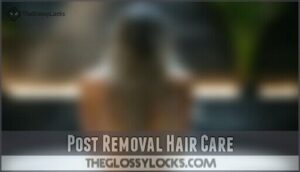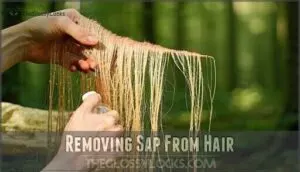This site is supported by our readers. We may earn a commission, at no cost to you, if you purchase through links.

Let it sit for 5-10 minutes to break down the sap. You can also use peanut butter or mayonnaise as alternatives—their oils work the same way.
For stubborn spots, try rubbing alcohol or hand sanitizer. Once the sap loosens, wash your hair thoroughly with shampoo, possibly twice.
Comb through while conditioning to remove any remaining residue. The right technique depends on how much sap you’re dealing with and what household remedies you have on hand, using the best technique.
Table Of Contents
Key Takeaways
- Use oils like olive, coconut, or vegetable oil to break down sap—massage it in, let it sit for 10-15 minutes, then wash with shampoo.
- Peanut butter and mayonnaise are effective alternatives; their oils loosen sap while conditioning your hair.
- For hardened sap, try rubbing alcohol, hand sanitizer, or even nail polish remover sparingly, then wash thoroughly.
- Protect unaffected hair by sectioning it off with clips and applying oil to nearby strands to prevent sap from spreading.
Removing Sap From Hair
You’ll find tree sap in your hair doesn’t have to be a sticky disaster when you know the right removal techniques.
With household items like oils, peanut butter, or even rubbing alcohol, you can safely break down the sap without damaging your locks.
Preparing for Sap Removal
When you’re faced with sticky tree sap in hair, proper preparation makes all the difference.
Before diving into sap removal, follow these essential steps:
- Assess sap severity to choose the right method
- Gather supplies like oils, combs, and old towels
- Protect clothing with a cape or old shirt
- Patch test any removal products first
Acting quickly prevents the sap from hardening and causing more hair damage.
Using natural moisturizing ingredients beforehand can also protect the hair.
Safeguarding Unaffected Hair
Now that you’re ready to tackle sap in hair, first protect the unaffected strands.
Section off clean hair with clips or ties to create protective hairstyles that keep sap from spreading.
Apply a light coat of preemptive oiling to nearby strands as a barrier.
This simple hair care tip prevents sap from sticking to more hair during removal, saving you from additional hair damage prevention efforts later, and it is a good example of complete concepts.
Initial Steps for Removal
Now that you’ve protected the rest of your hair, it’s time to assess sap severity before taking action.
Gently detangle hair around the affected area using a wide-tooth comb. Gather supplies based on how stubborn the sap appears.
Choose your method—oils work well for fresh sap while alcohol-based solutions tackle hardened residue.
Protect your clothing with an old towel to catch drips during the process. Don’t panic—sap removal from hair is totally doable.
Get Sap Out of Hair
Once your hair becomes sticky with tree sap, you’ll need to act quickly before it hardens completely. Getting sap out of hair requires patience and the right approach to avoid damaging your locks.
Start by applying a DIY sap remover like vegetable oil directly to the affected area. Gently work it into the sap-stuck hair using your fingers, avoiding pulling or tugging.
Sap hardening factors include exposure to air and heat, so address the problem as soon as possible. For kids and sap encounters, remain calm and explain each step to prevent anxiety.
Sometimes professional help is needed if home hair cleaning methods fail, especially with large amounts or extremely hardened sap. Remember that sap removal safety is essential—avoid cutting hair unless absolutely necessary.
With these sap removal tips, that sticky situation will soon be resolved. You can also use conditioner, much like when you remove silly putty.
Oil Based Sap Removal
You’ll find that oils are your secret weapon against stubborn tree sap in hair, working by breaking down the sticky residue for easy removal.
Common household oils like olive oil, coconut oil, and vegetable oil can be massaged into affected hair areas, left to sit for 10-15 minutes, and then shampooed out to restore your hair’s natural shine, using a process that involves breaking down the residue.
Utilizing Common Kitchen Oils
Your kitchen pantry holds powerful allies in the battle against stubborn sap in hair. Common cooking oils work wonders for breaking down sticky tree residue.
For successful oil-based sap removal:
- Apply vegetable or olive oil directly to the affected area
- Gently massage the oil into the sap for 2-3 minutes
- Let the oil sit for 10-15 minutes to break down the sticky substance
After application, the sap should loosen enough to comb out easily.
Specialty Oils and Hair Care
While common kitchen oils work well, specialty oils offer extra benefits for your hair while removing sap.
These premium options also tackle sticky situations and improve scalp health and add shine enhancement.
You can find products related to argan oil benefits.
| Oil Type | Benefits | Application Techniques |
|---|---|---|
| Argan | Maintains color in dyed hair | Warm between palms, apply directly to sap |
| Jojoba | Adds moisture to all hair types | Massage into affected areas for 10 minutes |
| Baobab | Repairs dry, damaged hair | Apply generously, cover with shower cap |
| Sweet Almond | Reduces breakage and split ends | Work through with wide-tooth comb |
The application techniques for each oil type are designed to maximize their benefits, such as maintaining color, adding moisture, repairing damage, and reducing breakage.
Each oil has its unique benefits and uses, making them suitable for different hair types and needs.
Peanut Butter and Mayonnaise
Slather creamy peanut butter directly onto sap-affected hair strands.
The oils in peanut butter break down stubborn sap while nourishing your scalp.
For an equally effective alternative, mayonnaise works wonders with its egg and oil combination.
Apply either substance generously, massage gently for 10-15 minutes, then comb through before shampooing.
Both options remove sap effectively while conditioning hair, making the ordeal less sticky, and providing a generous amount of nourishment.
Alternative Sap Removal Methods
You’ll find several alternative methods to remove stubborn sap from your hair beyond just using oils.
From alcohol-based solutions to specialized soaps and simple mechanical techniques, these proven options can save your locks when you’re fresh out of peanut butter or cooking oil, using specialized soaps.
Alcohol-Based Alternatives
While oils work wonders, sometimes you need something stronger.
Rubbing alcohol or isopropyl alcohol offers a gentle yet effective option to remove sap from hair. Simply apply a small amount to the sticky area, then work it through with your fingers.
Alcohol-based hand sanitizer gel works too in a pinch. For stubborn sap, try nail polish remover, but use sparingly to avoid drying out your hair.
Soap and Detergent Options
While alcohol solutions work well on stubborn sap, don’t overlook the power of everyday soaps. Dish soap mixed with warm water directly tackles sticky spots in your hair.
Simply apply the solution to sappy areas and gently work it through. Dawn is particularly effective for residue removal.
Laundry detergent mixed with warm water offers another option, though gentler formulas are best. For natural soaps, hand sanitizer followed by shampoo creates a one-two punch that gets sap out fast.
Shaving soaps, known for their lubricating lather qualities, could also assist in removing sap, providing a lubricating effect and making the process easier with their one-two punch.
Mechanical Removal Techniques
While soaps work well for some situations, physical methods can be just as effective.
When sap has hardened in your hair, these mechanical removal techniques can save the day:
- Try the freezing method by applying ice packs to harden the sap for easier removal
- Use gentle scraping tools like a fine-tooth comb to lift away sap
- Practice the blotting action with paper towels to absorb loosened residue
- Combine physical manipulation with oil-based cleaners like peanut butter or cooking oil
For targeted cooling, consider using specialized hair icepacks.
Post Removal Hair Care

After you’ve successfully removed sap from your hair, you’ll need to restore its natural health and shine.
A good shampooing followed by deep conditioning will help repair any damage caused during the removal process.
Shampooing and Conditioning
Now that you’ve removed the sticky mess, it’s time to get your hair truly clean. Choose a clarifying shampoo to eliminate any lingering oil residue from your sap removal treatment.
If you’re looking to buy, consider shampoo product options.
Wash twice if needed, then follow with a nourishing conditioner rich in moisturizing ingredients.
For stubborn residue, try a vinegar rinse (1 tablespoon in 1 cup water) before shampooing to restore your hair’s natural pH and shine.
Restoring Hair Health
Now that your hair is clean, it’s time to bring it back to life. Tree sap can leave your hair feeling dry and damaged, so proper restoration is key for maintaining scalp health.
Here’s how to revive your hair after sap removal:
- Apply a deep conditioner for 15-20 minutes to restore natural shine
- Use a banana hair mask for added hydration and protein
- Try a leave-in conditioner to protect damaged strands
- Massage your scalp gently to promote hair growth
By following these steps, you can help restore your hair’s natural health and appearance, making it look and feel its best after the removal of tree sap.
Preventing Future Sap Incidents
To keep sap out of your hair in the future, take these simple prevention steps. Wear hats when hiking through wooded areas and use hair-ties to keep locks secure.
Regular washing helps prevent sap from sticking firmly to hair. To avoid irritation, consider soothing skin after washing.
| Prevention Tip | Benefit | When to Use |
|---|---|---|
| Wear hats | Physical barrier | Hiking, camping |
| Check surroundings | Avoid sappy trees | Outdoor activities |
| Use hair-ties | Minimizes exposure | Any outdoor adventure |
The provided tips are essential for minimizing exposure to sap and other outdoor elements that could cause hair and skin irritation, making them crucial for a comfortable outdoor adventure.
Frequently Asked Questions (FAQs)
How to remove tree sap out of hair?
Like Hercules facing a sticky challenge, apply peanut butter or vegetable oil to the sap, massage it in for 10-15 minutes.
Then comb out the loosened sap before shampooing your hair as usual.
Does Dawn soap remove sap?
Yes, Dawn dish soap can effectively remove sap from hair.
You’ll need to lather it into the affected area, work it gently through the strands, then rinse thoroughly.
Follow with regular shampoo and conditioner.
How to remove dried sap quickly?
Ah, stuck in a sticky situation? Freeze the sap with ice, then scrape it off.
For stubborn spots, apply peanut butter, olive oil, or rubbing alcohol. Let it sit briefly, then wash thoroughly with shampoo.
Will sap cause hair damage?
Sap won’t outright damage your hair, but it can tangle and dry it out if left untreated.
Removing sap promptly using oils or peanut butter helps keep your hair healthy, shiny, and trouble-free.
Can commercial products remove sap effectively?
Commercial products like rubbing alcohol, Goo Gone, or mineral spirits work wonders for sap removal.
They break down sticky residues quickly.
Always test a small spot first, follow instructions, and rinse thoroughly to avoid harm.
How to handle sap in childrens hair?
To remove sap from your child’s hair, massage in peanut butter or olive oil.
Let it sit for 10 minutes, then comb out the sap.
Wash with shampoo, and finish with conditioner for shine.
How long does sap removal typically take?
Getting sap out of hair isn’t an instant fix—it’s like untangling a sticky puzzle.
Depending on the amount, it typically takes 15-30 minutes, with oils, combs, and patience being your best allies.
Conclusion
Tackling sticky situations like sap in your hair doesn’t have to be intimidating.
By using household remedies like oils, peanut butter, or rubbing alcohol, you can quickly loosen the sap and clean your hair effectively.
Remember to rinse thoroughly with shampoo and condition to restore your hair’s health.
Whether it’s a little sap or a stubborn patch, these techniques make it easy to get sap out of hair and leave it looking fresh and smooth.







